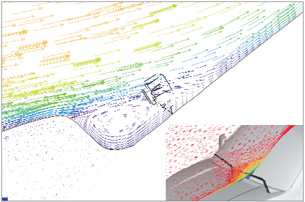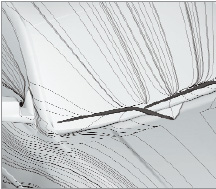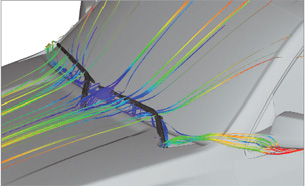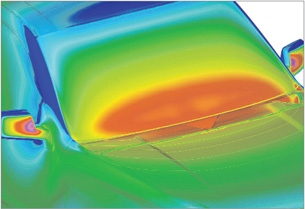Latest News
March 3, 2008
By Douglas Clark
 This is a cross-section of the aerodynamic model showing velocity vectors around the wipers. Theinset image is a three-quarter view of the model showing the same vectors. (image courtesy of GM) |
When storm clouds suddenly unleash beating rain, every driver is relieved when the wipers take their first swipe across the windshield, bringing the road back into view. But as real as this relief might be in rainy weather, it’s easy to forget about the wipers when the weather is dry — or at least that’s the case in newer cars and trucks from General Motors. That’s because GM engineers use computational fluid dynamics (CFD) to reduce the whooshing and whistling noises that wipers create, keeping wipers out of mind until the next rainfall.
The wiper challenge
“Because tire and engine noise has been reduced with various kinds of new technology, wind noise becomes a greater overall contributor to what can be heard inside the automobile,” says Ken Karbon, a staff engineer at GM who specializes in aerodynamics, “and wipers are potentially a significant source of wind noise.”
When you consider that wind noise consistently ranks high among concerns in car consumer surveys, wipers are suddenly no small matter. Furthermore, where there’s noise, there’s generally aerodynamic drag, which auto manufacturers seek to minimize for improved fuel efficiency.
The most obvious way to eliminate wiper wind noise would be to tuck idle wipers out of sight — and thus out of the airflow — as was the case many years ago. Compact cars, however, have less room under the hood to stow wipers and associated components and when wipers reemerged from beneath the hood’s edge, they immediately gained status as styling elements designed to add character to automobiles and attract potential buyers.
| What a drag General Motors closely evaluates the aerodynamic performance of its vehicles, whether they’re designing racing vehicles or simply making the latest model even quieter and more fuel-efficient. |
Balancing style with performance
Traditionally, the wind tunnel was where you determined whether the right balance had been struck between styling and performance as noise levels and aerodynamics were compared to accepted standards. Acoustic vehicle prototypes, though, aren’t generally ready until fairly late in the design process, leaving little room for error. And any surprises in the wind tunnel could jeopardize the entire production schedule.
“By traditional methods, there was some minor tweaking we could do around the wipers,” notes Karbon, “but in some cases we had no choice but to make changes that weren’t ideal, like using thicker windshield glass, which adds mass, to prevent the transmission of the noise to the inside of the car, rather than tackling the source of the noise. Per federal safety standards, cleaning performance must also be preserved with any change to the wiper system.”
The added cost and frustration of having to sometimes make late changes prompted Karbon to develop a new process to optimize wiper design early in the schedule.
 Surface-restrict particle traces simulate oil streaks and identify near-wall flow behavior.(Photo courtesy of GM.) |
Virtual simulations streamline the process
Engineers are now able to greatly reduce the element of wind-tunnel surprises using virtual airflow simulations. As a matter of course, an aerodynamics CFD model is made by GM analysts for every new car design. Karbon decided to take advantage of this existing work and now uses these CFD models in a new process that ensures that windshield wipers won’t affect a vehicle’s timely completion.
Karbon analyzes the proposed wiper geometry with the CFD model using EnSight, a visualization software program from Computational Engineering International (CEI) of Apex, NC. Using proprietary codes developed by GM engineers, the EnSight visualization can clearly indicate areas of the proposed design where wind noise is higher than GM’s acceptable standards.
| Windshield wiper primer Windshield wipers seem like a matter of common sense, but the world went without them until Mary Anderson watched a New York City streetcar driver reach out the window to clean his windshield. Read more about the history of the wiper here. And learn more about the inner workings of the windshield wiper here. |
“Now it’s a matter of hours to check the wind noise created by the wipers. And these wiper results are practically free since we utilize existing aerodynamics models,” says Karbon. “Using one CFD simulation to produce a variety of useful results shows the power of computer-aided engineering.”
Thanks to the new method, just a couple of hours of work give GM valuable wind-noise data six to eight months before the new vehicle prototype ever arrives in the wind tunnel. In other words, the team has the luxury of these months to fine-tune and adjust designs to reduce wiper wind noise to acceptable levels.
 Velocity streamlines in the wiper region identify complex airflow patterns. (Image courtesy of GM.) |
One of the reasons the process has also been so effective is because EnSight has made it easy to explain and share results with engineering colleagues, or with automotive stylists and other nontechnical members of the team.
“The visual results have been a very effective communications tool — particularly with wiper designers. Graphics that show why the noise requirements are being violated tell the whole story. It’s no longer just an engineer’s opinion,” explains Karbon.
In addition, because EnSight allows changes to be made on the fly, engineers can test various wiper positions and configurations, and then supply designers with specific parameters to consider, such as a particular zone on the windshield where wipers can rest while idle. The aim is to provide guidelines that allow room for creativity while still meeting wind-noise standards.
 Static pressure contours on the vehicle surface. (Image courtesy of GM.) |
“None of the techniques I’ve developed are possible with our other CFD tools,” says Karbon. “The postprocessing features of EnSight are just so much more powerful than any other software we use. It lets us create detailed images and manipulate the data in a way that really fits our approach.”
Not only has GM implemented effective measures for reducing wiper wind noise, but it has also created a better design environment. It has successfully reduced the industry’s traditional “drag” and “friction” between styling and engineering colleagues, which means better teamwork. The company is now looking at other areas, such as the designing of side rear-view mirrors, to continue building on its success with CFD and EnSight visualizations.
EnSight
Computational Engineering International (CEI)
Apex, NC
ensight.com
Douglas Clark is a freelance PR and marketing writer who specializes in science and technology. He is based in New York. You can send e-mail about this article to [email protected].
Subscribe to our FREE magazine, FREE email newsletters or both!
Latest News
About the Author
DE’s editors contribute news and new product announcements to Digital Engineering.
Press releases may be sent to them via [email protected].






